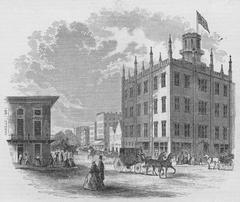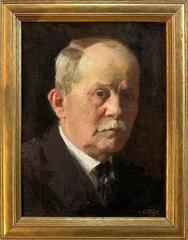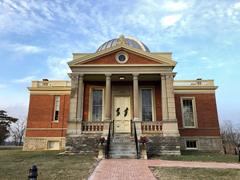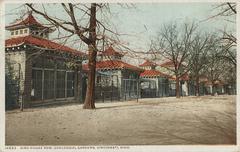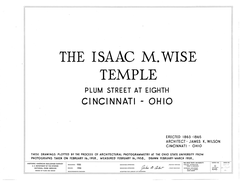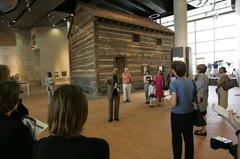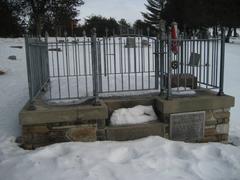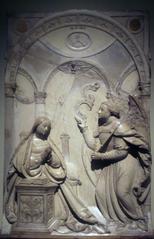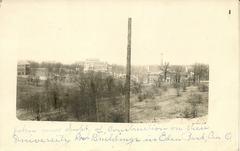Harriet Beecher Stowe House Cincinnati: Visiting Hours, Tickets, and Historical Significance
Date: 04/07/2025
Introduction
The Harriet Beecher Stowe House, located at 2950 Gilbert Avenue in Cincinnati’s Walnut Hills neighborhood, stands as an enduring monument to American social reform, literature, and African American resilience. This meticulously restored site honors Harriet Beecher Stowe—the influential abolitionist and author of Uncle Tom’s Cabin—while also reflecting the layered histories of abolitionism, women’s rights, and the African American experience in Cincinnati. The house’s dual legacy as the Beecher family home and, later, the Edgemont Inn (a Green Book-listed boarding house), invites visitors to explore the intersections of race, activism, and community.
For current visitor information, including hours, tickets, accessibility, and upcoming programs, refer to the Ohio History Connection or the official Stowe House website. (Ohio History Connection, Stowe House Official Site, Local 12 News)
Table of Contents
- Introduction
- Origins and the Beecher Family
- Harriet Beecher Stowe’s Formative Years in Cincinnati
- Inspiration for Uncle Tom’s Cabin
- The Edgemont Inn and African American History
- Restoration and Dual-Era Preservation
- Visiting Information: Hours, Tickets, and Accessibility
- Special Events and Guided Tours
- Nearby Attractions
- Frequently Asked Questions (FAQ)
- Visuals and Media
- Conclusion
- References
Origins and the Beecher Family
Built in 1833 as the president’s residence for Lane Theological Seminary, the house became home to Reverend Lyman Beecher and his large, reform-minded family. Lyman Beecher saw Cincinnati as a frontier for progressive Christian activism, and his children—most notably Harriet, Catharine, Henry Ward, Gen. James Beecher, and Isabella Beecher Hooker—became prominent advocates for abolition, women’s education, and suffrage (Ohio History Connection).
Harriet Beecher Stowe’s Formative Years in Cincinnati
Harriet Beecher Stowe lived in the house from 1833 until her marriage in 1836. In this vibrant household, she engaged with leading abolitionists and witnessed the realities of slavery firsthand, given Cincinnati’s proximity to Kentucky. Cincinnati’s burgeoning population and its active anti-slavery community made it a focal point in the national abolitionist movement (Wikipedia).
Inspiration for Uncle Tom’s Cabin
Stowe’s experiences in Cincinnati—including witnessing a slave auction in nearby Maysville, Kentucky—profoundly shaped her worldview. Her early writing career began here, culminating in the publication of Uncle Tom’s Cabin in 1852. The novel sold over 300,000 copies in its first year, was translated into more than 75 languages, and played a pivotal role in galvanizing anti-slavery sentiment both in the U.S. and abroad (Ohio History Connection).
The Edgemont Inn and African American History
In the 1930s and 1940s, the house became the Edgemont Inn—a Black-owned boarding house and tavern operated by Irene Bacon. Listed in the Negro Motorist Green Book, it provided a safe haven for African American travelers during segregation, reflecting Cincinnati’s significance as a center of Black community life and resilience (Local 12 News).
Restoration and Dual-Era Preservation
A comprehensive, $3.5 million restoration completed in 2024 returned the house to its 1840s appearance while also honoring its 1940s Edgemont Inn legacy. Key restoration efforts included:
- Removing 17 layers of paint to reveal the original yellow exterior
- Installing 44 new windows and 20 pairs of historically accurate shutters
- Rebuilding fireplaces, mantles, and period-specific interiors for both eras
- Restoring the Edgemont Inn rooms to reflect the African American experience during segregation
- Installing climate control and accessibility upgrades
These efforts ensure that the stories of both the Beecher family and Cincinnati’s Black community are preserved for future generations. (Fox19, Ideastream)
Visiting Information: Hours, Tickets, and Accessibility
Hours of Operation:
- Thursday–Saturday: 10:00 AM – 4:00 PM
- Sunday: 12:00 PM – 4:00 PM
- Last tour begins at 3:00 PM
Ticket Prices:
- Adults: $8
- Seniors and college students: $7
- Children (6–17): $5
- Children under 5: Free
Accessibility:
The site is wheelchair accessible, with ramps and accessible restrooms. Advance notice is encouraged for any visitors needing specific accommodations.
Location & Parking:
2950 Gilbert Ave., Cincinnati, OH 45206. Limited free parking is available on site; street parking and public transit options are nearby (official website).
Special Events and Guided Tours
Guided tours are highly recommended and provide in-depth insight into both the Beecher family’s reformist legacy and the Edgemont Inn’s role in Black history. The museum also offers lectures, reenactments, book talks, family programs, and community events throughout the year (Stowe House Events).
Nearby Attractions
Enhance your Cincinnati visit by exploring:
- National Underground Railroad Freedom Center
- Cincinnati Art Museum
- Eden Park and Krohn Conservatory
- Historic Walnut Hills neighborhood
Frequently Asked Questions (FAQ)
Q: What are the Harriet Beecher Stowe House visiting hours?
A: Thursday–Saturday 10:00 AM–4:00 PM, Sunday 12:00 PM–4:00 PM. Last tour at 3:00 PM.
Q: How much are tickets?
A: Adults $8, seniors/college students $7, children (6–17) $5, under 5 free.
Q: Is the house accessible for visitors with disabilities?
A: Yes, with ramps and accessible restrooms. Contact in advance for specific needs.
Q: Are guided tours available?
A: Yes, offered during open hours; group tours by appointment.
Q: Can I take photos inside?
A: Non-flash photography is generally allowed; confirm with staff for restrictions.
Q: Where can I park?
A: Limited free parking on-site; additional street parking nearby.
Visuals and Media
Explore high-quality photographs, virtual tours, and online exhibits on the museum’s website and exhibits page. Visual resources highlight the restored interiors, artifacts, and dual-era preservation.
Conclusion
The Harriet Beecher Stowe House is more than a preserved residence; it is a living testament to the ongoing struggles and triumphs of American reformers and the African American community. With its immersive exhibits, dual-era restoration, and dynamic community programming, the Stowe House stands at the crossroads of literature, abolitionism, and civil rights. Plan your visit today to experience this essential Cincinnati landmark. For up-to-date hours, tickets, and events, consult the official website or Ohio History Connection.
Enhance your visit with the Audiala mobile app for self-guided audio tours and follow the Harriet Beecher Stowe House on social media for the latest updates.
References
- Harriet Beecher Stowe House, Ohio History Connection
- Harriet Beecher Stowe House, Wikipedia
- Black History Month: Cincinnati Contributions & The Negro Motorist Green Book, Local 12 News, 2024
- Harriet Beecher Stowe House Restoration, Fox19, 2024
- Harriet Beecher Stowe House Restoration Events, Ideastream, 2024
- Official Harriet Beecher Stowe House Website
- Harriet Beecher Stowe House Reopening Coverage, Local12 News
- Stowe House Exhibits
- Stowe House Events
